Retinoid Market is estimated to be worth USD 2.70 Billion in 2024 and is projected to grow at a CAGR of 6.5 % between 2024 to 2032. The study has considered the base year as 2023, which estimates the market size of the market, and the forecast period is 2024 to 2032. The report analyses and forecasts the market size, in terms of value (USD Billion), for the market. The report segments the market and forecasts it by Type, by Application, by End User and by region/country.
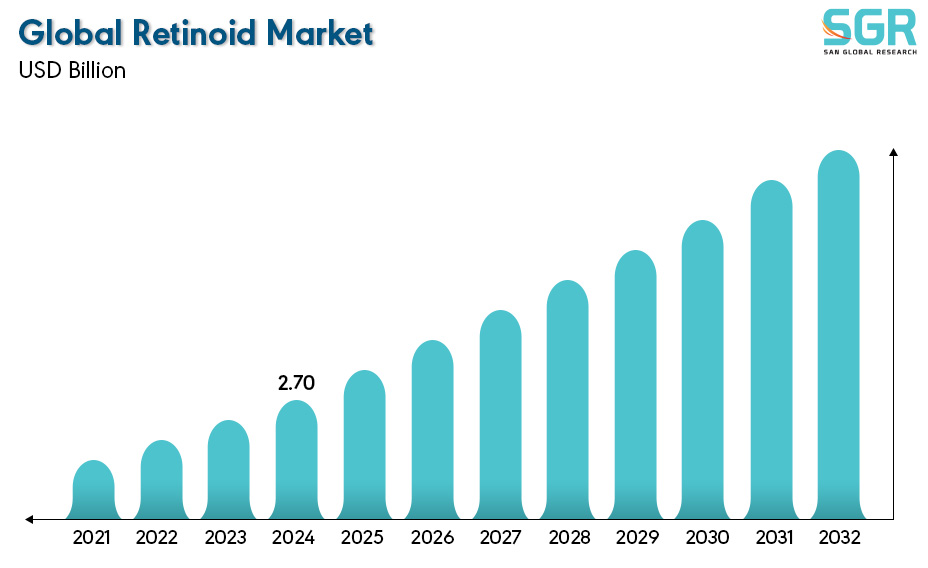
Retinoids are a group of natural and synthetic molecules related to vitamin A. They share a common structure based on four isoprene units linked head-to-tail, and some retinoids, like retinol and retinoic acid, also contain a β-ionone fragment. These molecules can be natural, like vitamin A itself, or synthetic analogs with similar properties. Notably, synthetic retinoids often contain a benzene ring instead of a cyclohexane ring. Due to their diverse structures, retinoids are classified into three generations. First generation retinoids are natural or slightly modified forms of vitamin A.
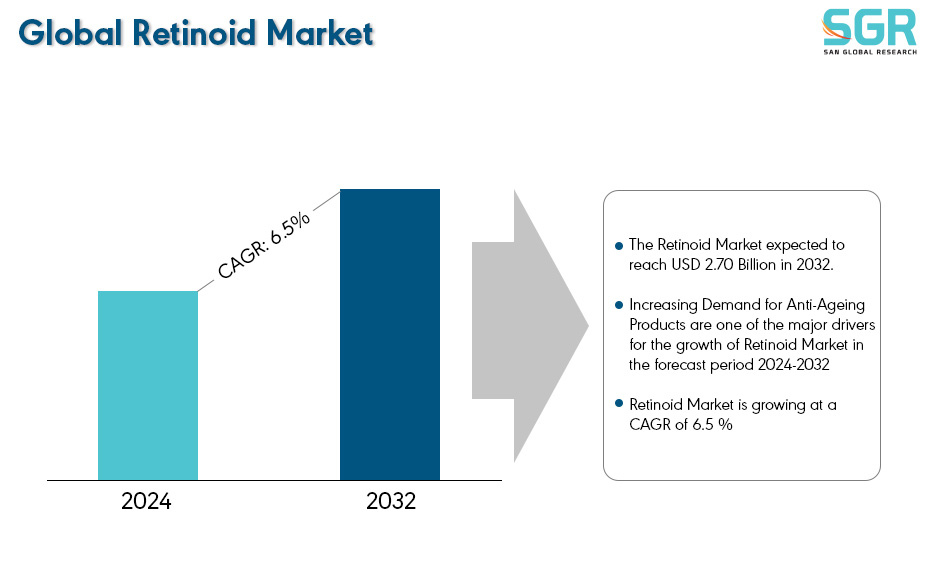
Second generation retinoids are synthetic molecules mimicking vitamin A but with a benzene ring replacing a cyclohexene ring. Third generation retinoids are also synthetic and contain additional aromatic rings, allowing them to target specific receptors. Overall, retinoids encompass a diverse range of molecules derived from vitamin A and find use in treating various skin conditions.
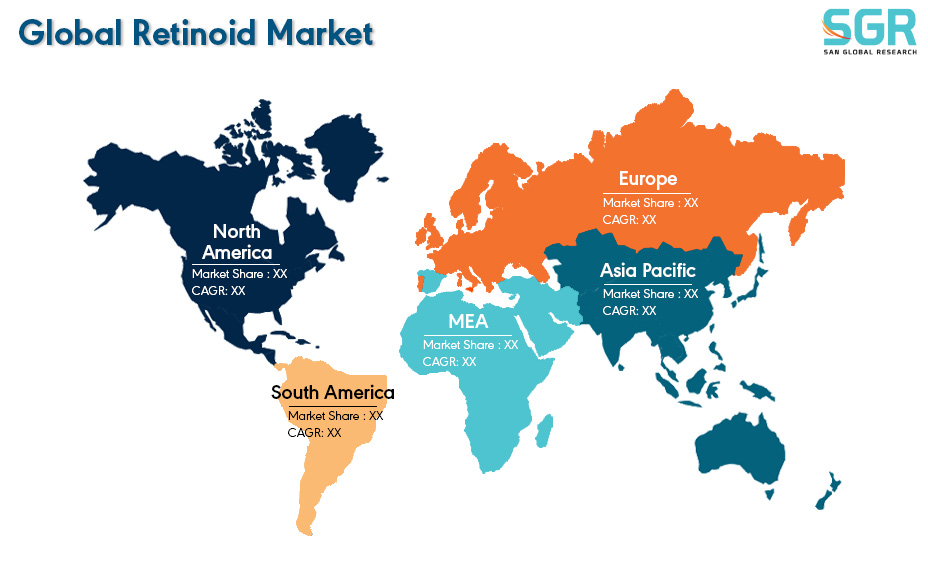
After reviewing the data shown below, it can be determined that the Asia Pacific region dominates the Retinoid Market for the following reasons.
North America is forecast to be the leader in the Retinoid Market. This is due to a rise in consumer interest in skincare, a booming beauty and cosmetics industry, and the presence of major players like GlaxoSmithKline Inc. and Bausch Health Companies Inc. in the region. Additionally, the United States and Canada are expected to be key drivers of this growth in North America, fuelled by increased awareness of the benefits of retinol in cosmetics and a strong demand for anti-aging products.

Segmentations
By Type
Based on Type, the Retinoid Market is bifurcated into Natural Retinoids and Synthetic Retinoids– where Natural Retinoids segment is dominating and ahead in terms of share. Synthetic retinoids offer several advantages for treating signs of aging skin. They might be more potent than natural retinoids, potentially delivering stronger results. They are significantly cheaper to produce than natural sources, making them more affordable for consumers. Additionally, some synthetic retinoids can be precisely targeted to address specific skin concerns, potentially reducing side effects. These factors have solidified synthetic retinoids as a dominant force within the retinoid market, particularly in cosmetics.

By Application
Based on Application, the Retinoid Market is bifurcated into Acne, Psoriasis, Anti-aging and Others– where Anti-aging segment is dominating and ahead in terms of share.
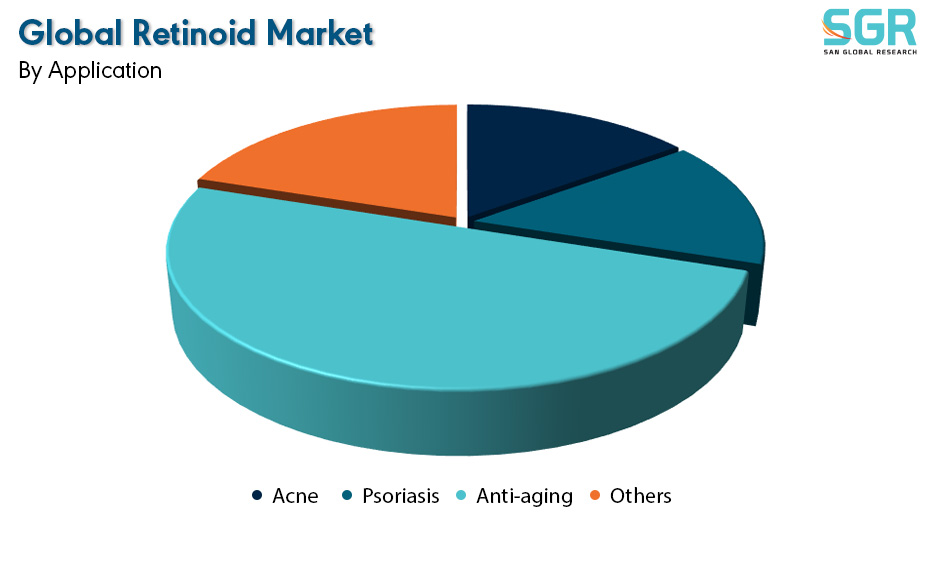
By Distribution Channel
Based on Distribution Channel, the Retinoid Market is bifurcated into Hospitals Pharmacies, Online Pharmacies, Retail Pharmacies, Supermarkets / Hypermarkets– where Retail Pharmacies segment is dominating and ahead in terms of share.
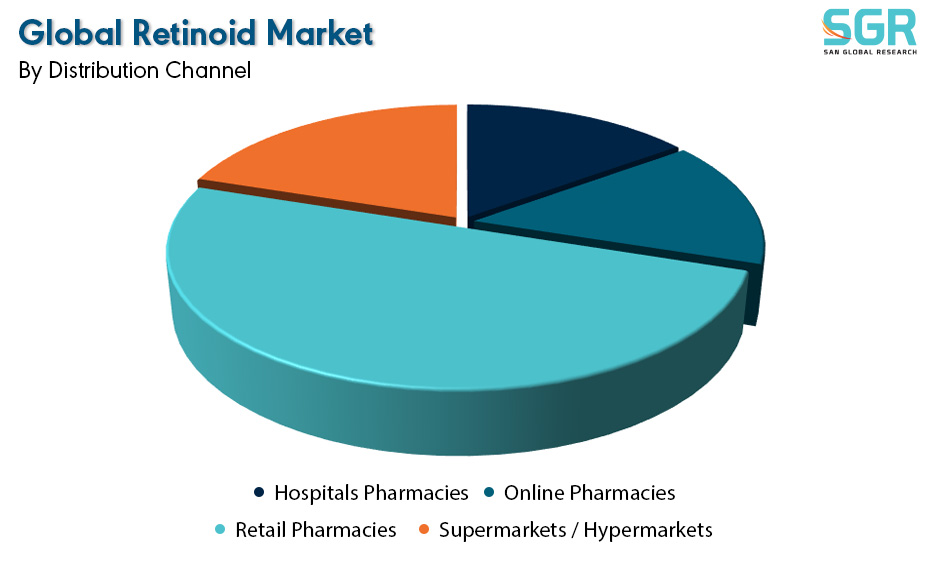
Key Players
• GlaxoSmithKline Inc.
• Mylan Pharmaceuticals Inc.
• Sun Pharmaceutical Industries Ltd.
• Janssen Pharmaceuticals Inc.
• Bausch Health Companies Inc.
Drivers
Increasing Demand for Anti-Ageing Products
The increasing demand for the anti-aging products is a key driver of the retinoid market. Retinol, a star player in the retinoid family, boasts scientific evidence for its ability to reduce wrinkles and promote youthful-looking skin. This, coupled with the growing focus on preventative skincare, is fuelling consumer demand for retinoid-based products. As people prioritize maintaining a youthful appearance rather than just reacting to visible signs of aging, the retinoid market is poised for continued expansion.
Opportunity
Innovations
There's significant evidence that Targeted Topical Delivery of Retinoids has significant benefits. This targeted delivery offers potential advantages for retinoid use. Studies suggest particle size and application method can influence penetration depth. This targeted approach could enhance the efficacy of retinoids for treating acne and other conditions concentrated in hair follicles and sebaceous glands, while potentially reducing irritation to surrounding skin. By improving delivery and minimizing side effects, targeted topical retinoids could become even more attractive for various skincare needs. These has shown significant market growth opportunity within the Retinoids market.
| Report Attribute | Details |
| Market Value in 2024 | 1.63 Billion |
| Forecast in 2032 | 2.70 Billion |
| CAGR | CAGR of 6.5% from 2024 to 2032 |
| Base Year of forecast | 2023 |
| Historical | 2019-2022 |
| Units | Revenue in USD Million and CAGR from 2024 to 2032 |
| Report Coverage | Revenue forecast, Industry outlook, Competitive Landscape, Growth Factors, and Trends |
| Segments Scope | by Type, by Application, by Distribution Channel |
| Regions Covered | North America, Europe, Asia Pacific, SA and MEA |
| Key Companies profiled | • GlaxoSmithKline Inc. • Mylan Pharmaceuticals Inc. • Sun Pharmaceutical Industries Ltd. • Janssen Pharmaceuticals Inc. • Bausch Health Companies Inc. |

 Description
Description
 Table of Content
Table of Content
 Gera Imperium Rise,
Gera Imperium Rise,  +91 9209275355
+91 9209275355


